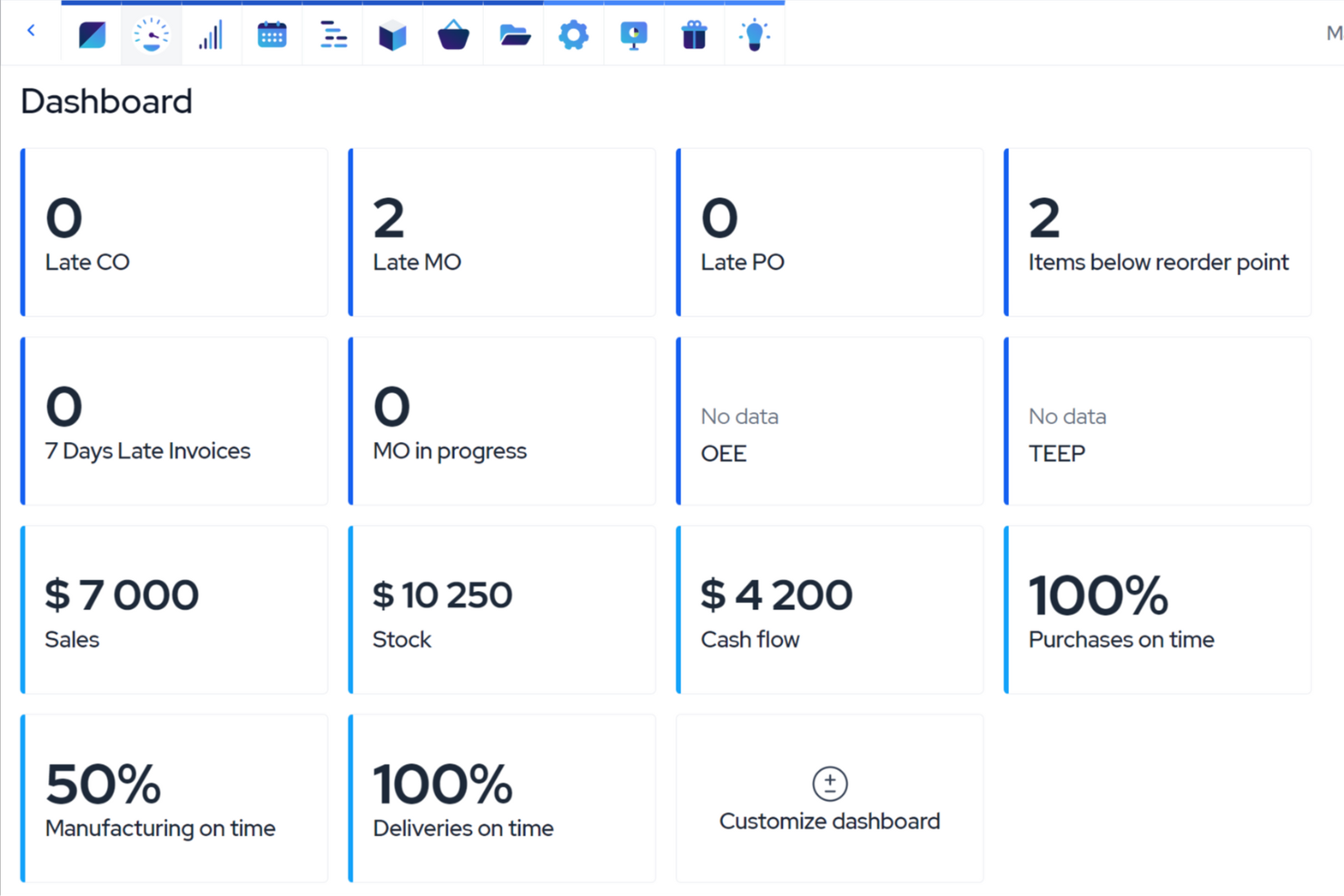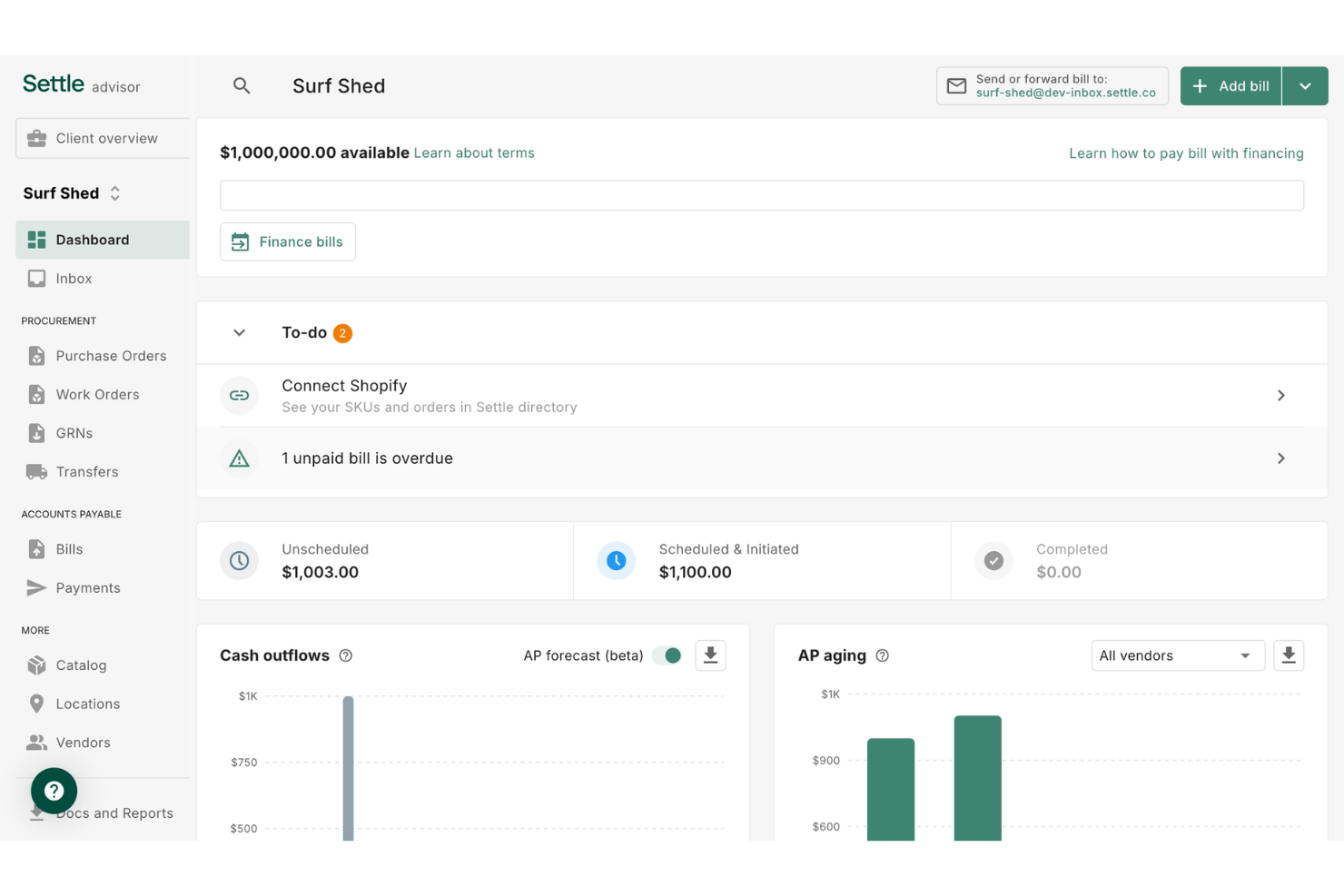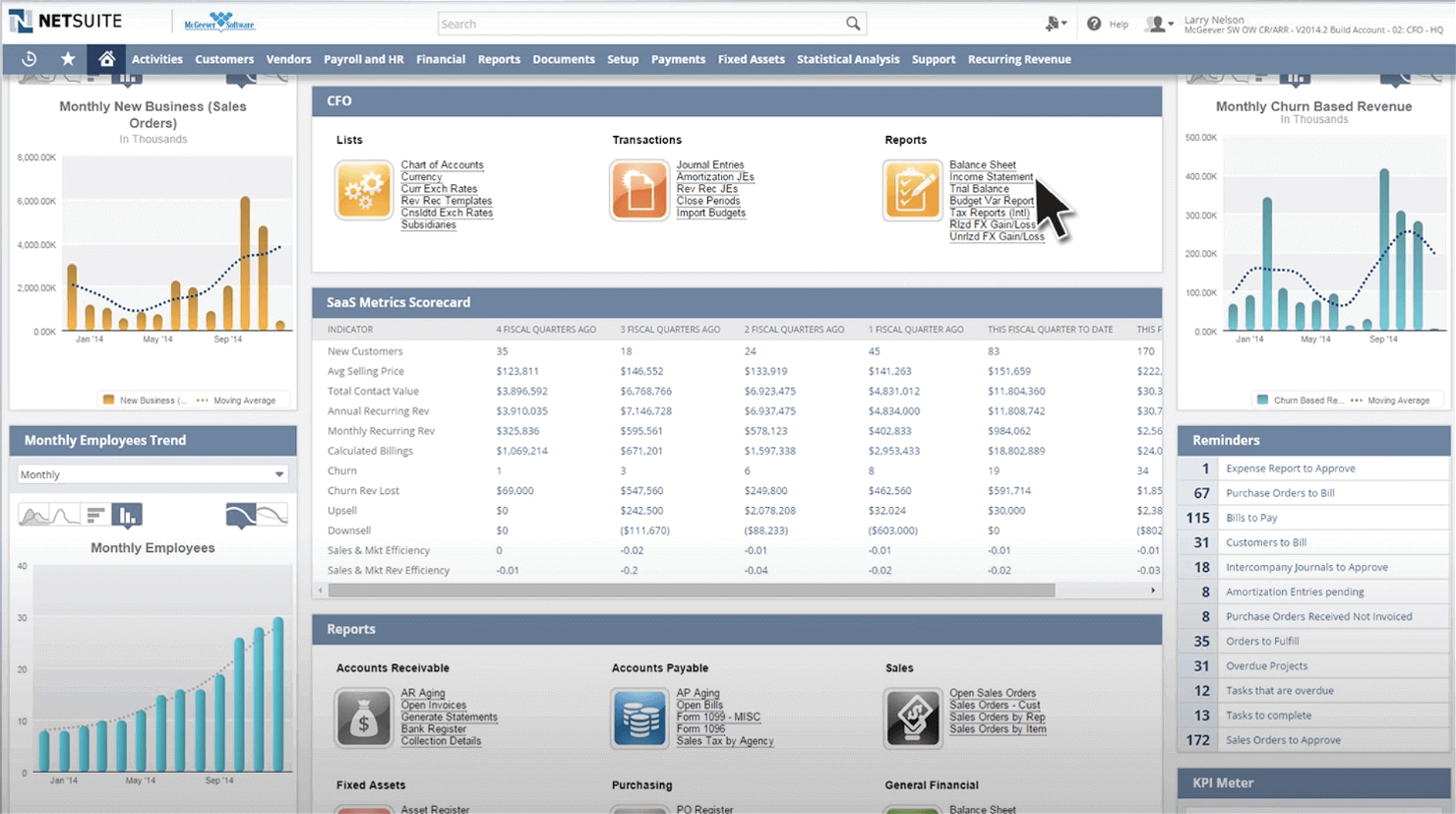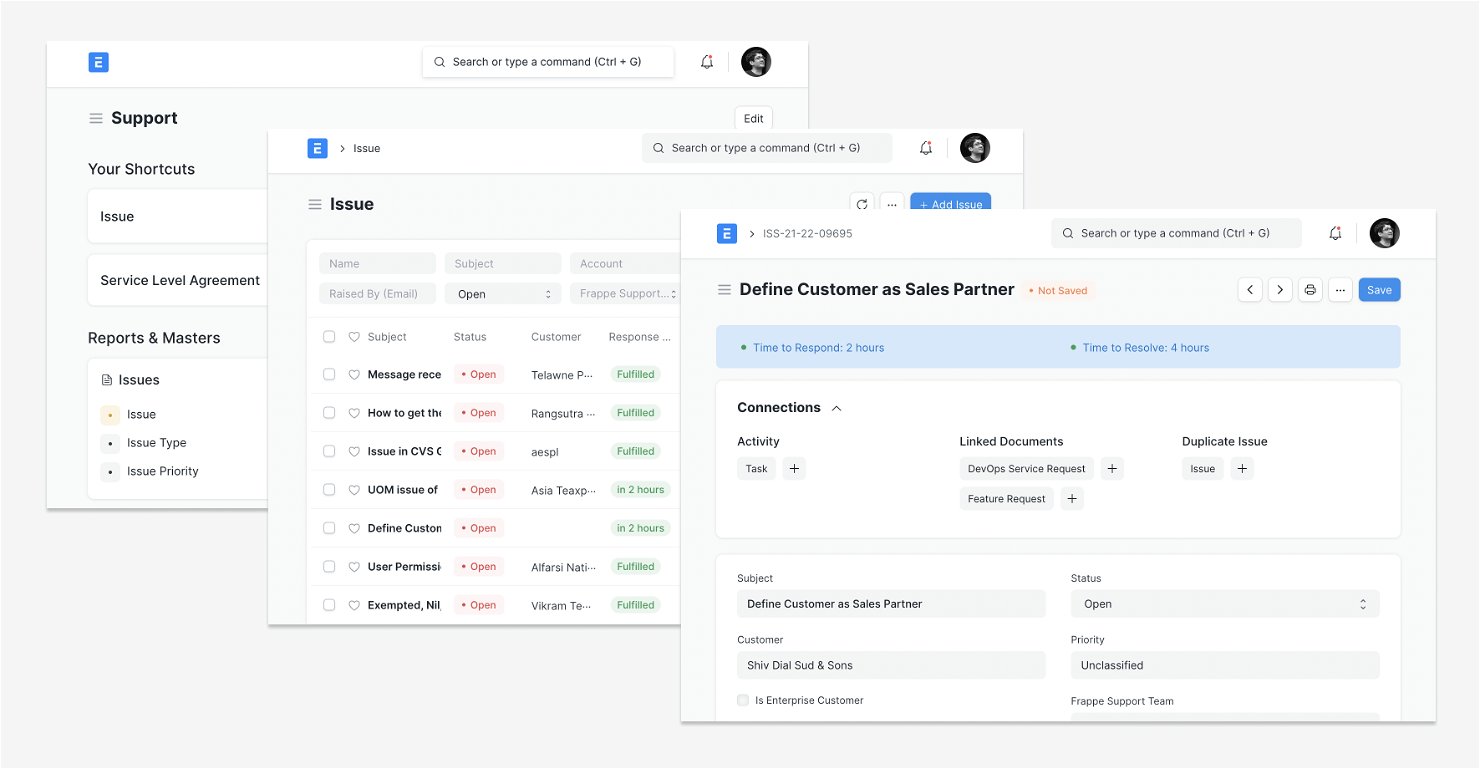Best ERP Software Shortlist
Here’s my shortlist of the best ERP software:
Our one-on-one guidance will help you find the perfect fit.
Enterprise resource planning (ERP) software is an integrated platform that helps businesses manage core processes like finance, HR, inventory, and operations from a single system. It's critical in streamlining workflows, unifying reporting, and gaining real-time visibility into business performance.
In my near-decade long career in fintech, I've helped numerous businesses find the right ERP software and accounting solutions. The wrong ERP tool can lead to fragmented data, missed revenue opportunities, and compliance issues that stall growth. But with the right solution, finance teams can efficiently manage financial data, collaborate on strategic planning, and maintain risk compliance.
After hours of hands-on testing, comparing features, evaluating customer support, and digging into user reviews, I’ve curated this list of top ERP software options. These tools are designed for growing tech businesses that need flexible, scalable, and intelligent systems to operate efficiently and make data-driven decisions with confidence.
Why Trust Our Software Reviews
We've been testing and reviewing accounting software since 2023, on a mission to make it easier to manage business finances. As financial operators ourselves, we know how critical it is to make the right decision when selecting software.
We invest in deep research to help our audience make better software purchasing decisions. We’ve tested more than 2,000 tools for different finance use cases and written over 1,000 comprehensive software reviews. Learn how we stay transparent & our accounting software review methodology.
Best ERP Software Summary
Use this quick-reference chart to easily compare pricing across top ERP software solutions.
| Tool | Best For | Trial Info | Price | ||
|---|---|---|---|---|---|
| 1 | Best AI-native ERP | Free demo available | Pricing upon request | Website | |
| 2 | Best for small manufacturers' visibility | 30-day free trial | From $49/user/month | Website | |
| 3 | Best for managing global finances | Freemium plan | $13/user/month | Website | |
| 4 | Best for small CPG businesses | Free plan available | From $199/month | Website | |
| 5 | Best for growing teams | Free demo available | Pricing upon request | Website | |
| 6 | Best for integrations | Free demo available | From $180/user/month | Website | |
| 7 | Best for cloud-based workflows | Free demo available | From $1,000/month | Website | |
| 8 | Best for nonprofits | Free demo available | From $630/year | Website | |
| 9 | Best open-source ERP software | Free trial available | From $5/month onwards | Website | |
| 10 | Best for complex supply chains | Free demo available | Pricing upon request | Website |
-

LiveFlow
Visit WebsiteThis is an aggregated rating for this tool including ratings from Crozdesk users and ratings from other sites.4.9 -

Float Financial
Visit Website -

Vena
Visit WebsiteThis is an aggregated rating for this tool including ratings from Crozdesk users and ratings from other sites.4.5
Best ERP Software Reviews
Here’s my reviews of the top ERP software vendors out there, complete with features, pros and cons, and integrations. If you’re deciding what fits best, this snapshot helps you focus on what actually drives results.
DualEntry is an AI-native ERP that handles your core accounting and financial workflows in the cloud. It gives your team a single system for managing tasks from procure‑to‑pay, quote‑to‑cash, and record‑to‑report.
Why I picked DualEntry: I chose DualEntry because its AI‑powered automation dramatically reduces manual work. It uses OCR to pull data from bills, invoices, and POs and auto‑logs them as transactions, plus it automatically categorizes and suggests entries so you don’t have to code everything manually. That same AI engine matches bank feeds—13,000+ live connections—against your ledger so you close faster without missing a thing.
Standout features & integrations:
Features include the ability to manage multiple entities and currencies and detect anomalies using continuous AI‑based auditing. It also provides advanced revenue recognition that supports ASC 606 and IFRS 15 with detailed waterfall reporting and configurable rules to handle complex contracts.
Integrations include BambooHR, Bill.com, Brex, Deel, Google SSO, Gusto, HubSpot, Ramp, Rippling, Salesforce, Stripe Billing, and Stripe Invoicing.
Pros and cons
Pros:
- Advanced AI features help with complex tasks
- Supports multi-entity and multi-currency operations
- Automated revenue recognition ensures compliance with standards
Cons:
- Depth of the platform may not be suitable for smaller teams
- Customization options require careful setup
MRPeasy stands out as a comprehensive ERP software solution specifically designed for small to midsized manufacturing companies. It simplifies complex processes through its intuitive cloud-based platform, making it easier for businesses to manage their operations efficiently and effectively.
Why I picked MRPeasy: In the realm of ERP software, MRPeasy excels by offering an all-in-one solution that integrates production planning, inventory control, and customer relations. This allows businesses to streamline their operations, reduce costs, and improve overall productivity.
Standout features & integrations:
Features include cloud-based access from anywhere, significantly enhancing flexibility for users. Additionally, its self-service customer portals improve customer interaction and service quality, offering a more engaging experience. To add to its strength, MRPeasy provides detailed analytics and reporting furnish insightful data, aiding in better decision-making by providing comprehensive visibility into operations and performance metrics.
Integrations include QuickBooks, Xero, Shopify, Magento, WooCommerce, Zapier, Salesforce, Mailchimp, Google Drive, and Slack.
Pros and cons
Pros:
- Excellent customer support ensures issues are resolved quickly
- Comprehensive functionality covers a wide range of business processes
- Affordable pricing model makes it accessible for smaller businesses
Cons:
- Integration with some niche or specialized tools may require additional work
- Limited customization options may not meet specific business needs
New Product Updates from MRPeasy
PDF Editor at MRPeasy Now Supports Direct URL for Logos
The PDF Editor at MRPeasy now supports using a direct URL for logo images, provided the image is publicly accessible without authentication. For more details, visit MRPeasy Changelog.
VOGSY is an all-in-one CRM and ERP solution designed for global project teams. It provides a unified platform for managing people, projects, and finances across multiple countries and currencies.
Why I Picked VOGSY: I chose VOGSY for this list because it simplifies managing international operations, from setting up new countries to tracking global projects. Its resource-based revenue forecasting supports smarter financial planning, while consolidated reporting delivers clear insights into revenue, costs, and margins across regions—ideal for CFOs overseeing complex, multi-country finances.
Standout features & integrations:
Features include the ability to report revenue, cost, and margins for local offices and consolidated worldwide, which helps you maintain a global yet localized financial overview. You can also integrate multiple local accounting tools for a seamless AR and AP process, ensuring that you're equipped to handle diverse financial systems. Additionally, VOGSY offers integrated billing schedules to keep your cash flow on track, so you don't miss out on essential financial opportunities.
Integrations include Quickbooks, Deltek, Xero, Sage, Certinia, Oracle Netsuite, Exact, PHC-GO, Tally, Wave, ABSS, and Omie.
Pros and cons
Pros:
- Real-time global financial overview
- Fast setup and onboarding
- Robust resource planning tools
Cons:
- Limited mobile functionality
- Basic customization options feel restrictive
Settle is a comprehensive cash flow management and financing tool tailored for small businesses, particularly those in the consumer packaged goods (CPG) sector.
Why I picked Settle: With Settle, your team can manage payments, vendors, and inventory all in one place. The tool provides financing options, allowing you to delay vendor payments while still meeting supply chain obligations. Its automated payment workflows help reduce time spent managing finances. Additionally, Settle's inventory management and forecasting capabilities help ensure you never stock out or overstock, while centralized tracking allows you to manage your catalog, BOMs, and work orders.
Standout features & integrations:
Features include AP automation that simplifies the process of tracking and managing invoices, ensuring timely payments and reducing manual errors. This feature is particularly beneficial if you handle a high volume of transactions. Additionally, Settle's purchase order management tools enhance procurement processes and help maintain appropriate levels of inventory.
Integrations include QuickBooks Online, NetSuite, Shopify, Amazon, Cin7, Google, and Xero.
Pros and cons
Pros:
- Inventory management and forecasting
- Automated invoice management
- Comprehensive financial dashboard
Cons:
- Could offer more advanced reporting features
- Complex setup
New Product Updates from Settle
Shared Visibility: The Key to Supply Chain Success
Settle has launched powerful new features, milestones and multiple shipments, designed to bring clarity, transparency, and true partnership to the supply chain process. With these features, brands and vendors can finally align on timelines and expectations without the frustrating back-and-forth. More details at Settle's blog.
NetSuite is a cloud-based enterprise resource planning (ERP) software suite designed to help businesses manage their core processes, including financials, CRM, inventory, and more, in one integrated platform.
Why I picked NetSuite: As someone who's familiar with ERP solutions, NetSuite stands out as an all-in-one platform that does everything from accounting to inventory management. I think it’s perfect for growing teams that need to scale their operations because it has a wide range of features and integrations that help businesses make smarter choices with their data.
Standout features & integrations:
Features include financial management, inventory management, and various supply chain tools that support your operational business systems. In addition, the CRM, ecommerce, project management, HRM tools, SuiteCloud platform, real-time reporting, and KPI tracking are great for managing a growing business and making decisions based on accurate data.
Integrations include Salesforce, Shopify, Avalara, Amazon Marketplace, eBay, Magento, PayPal, Square, Marketo, and HubSpot.
Pros and cons
Pros:
- Wide range of integrations with third-party software and services
- Multi-currency and multi-language support for global businesses
Cons:
- Limited mobile app functionality
- Limited options for user interface customization
- Requires significant customization and configuration to meet specific business needs
Microsoft Dynamics 365 Business Central is a cloud-based enterprise resource planning (ERP) software designed for small and medium-sized businesses.
Why I picked Microsoft Dynamics 365 Business Central: If you're looking for ERP software that prioritizes integrations, my top recommendation is Microsoft Dynamics 365 Business Central. Whether you need pre-built integrations, native connections to other Microsoft products, or an open API that allows for custom integrations, this ERP tool has it all.
Standout features & integrations:
Features include open API that allows for custom integrations and flexible tailoring to meet specific needs. Additionally, Microsoft's security and compliance protocols ensure safe data transfer between systems, making it an ideal choice for sensitive data or highly regulated industries.
Integrations include native Microsoft 365 connectors such as Outlook, Excel, Word, OneDrive, and Teams. Its pre-built integrations include Shopify, Magento, PayPal, QuickBooks, Salesforce, ZohoCRM, Stripe, and AdobeSign.
Pros and cons
Pros:
- Robust security and compliance
- Multi-currency and multi-language support
- Wide-range of pre-built and native integrations
Cons:
- Limited offline functionality for mobile app
- Limited scalability for on-premise deployments
Acumatica is a cloud-based enterprise resource planning (ERP) software solution designed for small and medium-sized businesses.
Why I picked Acumatica: I chose Acumatica for this list because it’s built from the ground up for the cloud. Its true cloud architecture means you can access real-time data from anywhere, on any device, without relying on clunky VPNs or local servers. Acumatica also offers flexible deployment options, seamless remote collaboration, and easy scalability—making it ideal for growing teams that need to stay connected and agile across locations.
Standout features & integrations:
Features include its modular design, which allows businesses to choose the modules they need to meet their specific requirements and customize the software to their specific workflows. Acumatica also offers strong financial management functionalities that comply with accounting standards such as GAAP and IFRS, providing businesses with real-time insights into their financial health.
Integrations include Salesforce, HubSpot, Shopify, Magento, Docusign, Smartsheet, Avalara, PayPal, and Microsoft Office 365.
Pros and cons
Pros:
- Real-time reporting
- Mobile accessibility
- Cloud-based
Cons:
- Lack of pricing transparency
- Limited industry-specific solutions
TallyPrime is an accounting software designed for small and medium-sized businesses, offering features such as financial accounting, inventory management, and GST compliance.
Why I picked TallyPrime: After reviewing TallyPrime’s ERP services, I would highly recommend this platform for nonprofits on a tight budget looking for a reliable and cost-effective ERP solution. TallyPrime is a reliable and user-friendly ERP solution that provides affordable pricing and an intuitive design, making it accessible for non-technical users who may not have a dedicated IT team.
Standout features & integrations:
Features include financial management capabilities such as accounting, billing, inventory management, and payroll processing, with real-time financial reporting to streamline accounting processes. Additionally, TallyPrime's remote access and compliance features provide accessibility and regulatory compliance for organizations.
Integrations include Microsoft Excel, Google Sheets, PayPal, AWS, Shopify, Magento, Zoho CRM, QuickBooks, and Razorpay.
Pros and cons
Pros:
- Easy-to-use
- Remote access
- Flexible pricing plans
Cons:
- Lacks advanced reporting and analytics
- Lack of scalability
ERPNext is an open-source enterprise resource planning (ERP) software designed to help businesses manage various aspects of their operations, including accounting, inventory management, CRM, and project management.
Why I picked ERPNext: For this list, I've chosen ERPnext as the top open-source ERP software out there. With ERPnext, businesses get a complete set of tools to manage their operations, finances, and customers all in one place. It's perfect for small and medium-sized companies looking for a budget-friendly solution to streamline their business processes.
Standout features & integrations:
Features include human resources tools like payroll and leave management, manufacturing modules for production planning and work orders, and a built-in help desk to manage customer support tickets. It also supports multi-currency and multi-company setups, and even includes a website builder and e-commerce tools.
Integrations include Twillo, Nexmo, Email, PayPal, Stripe, Shopify, WooCommerce, Salesforce, Google Suite, and Slack.
Pros and cons
Pros:
- Active community
- Mobile-friendly
- Open-source
Cons:
- Limited user support
- Limited scalability
Infor is a global provider of enterprise software solutions, offering industry-specific applications for various sectors such as manufacturing, distribution, healthcare, and more.
Why I picked Infor: I recommend Infor as the top ERP solution for businesses that have complex supply chains. Infor's ERP system is tailored to help businesses manage their supply chains more efficiently, no matter how many locations your business has. It has the bandwidth and resources to tackle logistical operations in both the front and back of the office and distribution centers.
Standout features & integrations:
Features include demand planning, inventory management, warehouse management, and transportation management. Infor's ERP system can also be tailored to meet the unique requirements and processes of each business, enabling them to efficiently manage their supply chains.
Integrations include Microsoft Office, Salesforce, Infor OS, Infor Coleman AI, Infor Document Management, Infor CRM, Infor Nexus, and Infor EAM.
Pros and cons
Pros:
- Mobile app
- Industry-specific solutions for verticals such as manufacturing, healthcare, and retail
- Multi-language and multi-currency support
Cons:
- Requires dedicated IT team for maintenance and updates
- Lack of pricing transparency
Other ERP Software
Here are some additional ERP software options that didn’t make it onto my shortlist, but are still worth checking out:
- Xledger
For accounting and financial teams
- Epicor Kinetic
For industry-specific features
- SAP ERP
For multinational organizations
- IFS Cloud
For asset-intensive operations
- Odoo ERP
For user experience
- WhereFour
For production through traceability
- Genius ERP
For small businesses
- Sage Intacct
For financial operations
- Deskera
For its automation capabilities
- Fulfil
For comprehensive order management
Related Reviews
If you still haven't found what you're looking for here, check out these other financially-focused business tools, that we've tested and evaluated:
- Accounting Software
- POS Systems
- Billing Software
- Payroll Services
- Best Merchant Services
- Inventory Management Software
ERP Software Selection Criteria
When I set out to find the best ERP software, I looked for tools that actually play well with what you already use, and grow with you. To make the search fair and focused, I followed a simple framework grounded in real-world needs:
Core Functionality (25% of total score)
To be considered for inclusion in this list, each solution had to fulfill these common use cases:
- Manage financial operations
- Handle human resources
- Oversee supply chain processes
- Support customer relationship management
- Provide reporting and analytics
Additional Standout Features (25% of total score)
To help further narrow down the competition, I also looked for unique features, such as:
- Advanced AI-driven analytics
- Customizable dashboards
- Mobile accessibility
- Integration with IoT devices
- Blockchain technology for data security
Usability (10% of total score)
To get a sense of the usability of each system, I considered the following:
- Ease of navigation
- Intuitive interface design
- Customizable workflows
- Speed of performance
- Accessibility options
Onboarding (10% of total score)
To evaluate the onboarding experience for each platform, I considered the following:
- Availability of training videos
- Interactive product tours
- Comprehensive user manuals
- Responsive chat support
- Access to webinars and workshops
Customer Support (10% of total score)
To assess each software provider’s customer support services, I considered the following:
- 24/7 availability
- Multichannel support options
- Dedicated account managers
- Community forums
- SLA-backed response times
Value For Money (10% of total score)
To evaluate the value for money of each platform, I considered the following:
- Competitive pricing tiers
- Transparent cost structure
- Availability of free trial
- Feature-to-price ratio
- Discounts for long-term commitments
Customer Reviews (10% of total score)
To get a sense of overall customer satisfaction, I considered the following when reading customer reviews:
- Feedback on reliability
- Ease of integration
- Overall user satisfaction
- Comments on customer support
- Comparative value perception
How to Choose ERP Software
With so many ERP tools making big promises, it’s easy to get lost in endless features and confusing pricing. If you’re here to find a reliable solution, this checklist will help you get started.
| Factor | What to Consider |
|---|---|
| Scalability | Whether you're a growing startup or a multi-entity enterprise, the best ERPs should grow with your business. Consider things like future expansion and increased data volume. |
| Integrations | Your ERP should connect seamlessly with your existing stack. Check compatibility with existing tools like CRM or accounting software to avoid disruptions. |
| Customizability | Every business has unique workflows. Look for options that let you tailor features to fit your team’s specific needs without expensive dev work. |
| Ease of Use | Complex doesn’t have to mean confusing. Choose an intuitive interface to minimize training time and boost productivity. |
| Budget | ERP software can range from freemium to six-figure enterprise contracts. Make sure to evaluate total cost of ownership, including upfront costs and ongoing maintenance fees ahead of time. |
| Security Safeguards | Financial data is sensitive. Prioritize data protection features like encryption and compliance with regulations. |
| Vendor Support | From implementation to troubleshooting, responsive support can make or break your ERP rollout. Consider the quality and availability of customer service and technical support. |
| Implementation Time | Some ERPs launch in days; others take months. Assess how long it'll take to get the ERP up and running within your organization. |
Trends In ERP Software
In my search, I reviewed recent product announcements, release notes, and vendor updates to identify key ERP system software trends. These are the ones that stood out for their ability to help streamline operations, boost visibility, and support growth:
- Integration with Artificial Intelligence (AI): ERP software solutions are increasingly being integrated with AI to enhance decision-making and predictive analytics, while streamlining documentation. This trend is vital for businesses looking to leverage data for strategic insights.
- Internet of Things (IoT) Integration: IoT devices are being connected to ERP systems to provide real-time data and insights. This is particularly beneficial for industries like manufacturing, where monitoring equipment health, supply chain management, and performance is essential.
- Enhanced Data Analytics: Advanced analytics capabilities within ERP systems are helping businesses turn data into actionable insights. This trend is growing as companies seek to improve efficiency and innovation.
- Cloud-Based ERP Solutions: The shift towards cloud-based ERP systems continues to grow, offering flexibility and scalability. This trend is particularly relevant for companies looking to reduce IT infrastructure costs and improve accessibility.
- User Experience Enhancements: Improving the user interface and user experience of ERP systems is becoming increasingly important. This trend focuses on making ERP systems more intuitive and user-friendly, thereby increasing user adoption and satisfaction.
What Is ERP Software?
ERP software is a centralized system that unifies core business functions. It’s used by professionals in finance, HR, operations, and supply chain to streamline workflows, reduce inefficiencies, and increase productivity.
Whether deployed via cloud, on-premise, or hybrid models, ERP software provides tools for inventory, revenue management, financial, and HR management, helping businesses make smarter, faster decisions.
Features of ERP Software
When evaluating ERP software solutions, focus on features that improve financial visibility, automate reporting, support compliance, and integrate with your existing systems. Other key features you'll likely need, include:
- Financial Management: Provides tools for managing financial operations, including accounting, budgeting, and cash flow, ensuring accurate financial reporting and compliance.
- Human Resources Management: Manages employee data, company payroll, recruitment, and performance evaluation, streamlining HR processes and improving workforce management.
- Supply Chain Management: Facilitates tracking and managing the flow of goods, services, and information across the supply chain to improve efficiency and reduce costs. This is highly beneficial for farmers, or those in oil and gas industries.
- Customer Relationship Management: Helps manage customer interactions, sales leads, and marketing efforts, enhancing customer satisfaction and sales performance.
- Inventory Management: Monitors and controls inventory levels, orders, and stock locations, optimizing stock levels to meet customer demand without overstocking. This is great if you're a startup company or SMB starting to expand.
- Manufacturing Management: Supports production planning, scheduling, and control, optimizing manufacturing processes and ensuring timely product delivery.
- Project Management: Provides tools for planning, executing, and monitoring projects, helping ensure projects are completed on time and within budget.
- Business Intelligence and Reporting: Offers analytics and reporting capabilities to provide insights into business performance and company expenses, aiding in informed decision-making.
- Integration Capabilities: Most ERPs, especially open-source solutions, offer seamless integration with other systems and applications, enhancing functionality and ensuring a unified IT environment.
- Compliance Management: Ensures adherence to industry regulations and standards, reducing the risk of non-compliance and associated penalties.
Benefits of ERP Software
ERP software streamlines finance, operations, and team workflows in one place. But that's not its only benefit. Here are a few other perks you can expect with ERP system software:
- Improved Data Accuracy: ERP systems, both accounting and standard, help centralize data, reducing errors and inconsistencies by ensuring everyone in the organization accesses the same information.
- Enhanced Collaboration: By integrating various business processes, ERP systems break down departmental silos, fostering better communication and teamwork.
- Cost Savings: Automating routine tasks with ERP solutions minimizes manual labor, decreases operational costs, and optimizes resource allocation. Some vendors even offer free ERP solutions to help startups and small businesses.
- Increased Efficiency: ERP software streamlines business processes, allowing employees to focus on more strategic tasks rather than repetitive, time-consuming activities.
- Regulatory Compliance: ERP systems often include compliance management features, helping businesses adhere to industry standards and regulations effortlessly. This is beneficial for businesses in healthcare, cybersecurity, and manufacturing industries, like chemical-based companies.
- Scalability: As companies grow, ERP solutions can be scaled to accommodate new business processes and increased data volume without significant changes.
- Improved Customer Service: By providing accurate and up-to-date information, ERP systems enable businesses to respond promptly to customer inquiries and needs. This is extremely beneficial for retail services and banking businesses.
Costs & Pricing for ERP Software Providers
ERP software pricing varies by features, users, and add-ons. I pulled together a clear table that compares common plans, average costs, and what each includes. If you're weighing options or budgeting for rollout, this gives you a fast way to see what might fit your team's size and priorities.
Plan Comparison Table for ERP Software
| Plan Type | Average Price | Common Features |
|---|---|---|
| Free Plan | $0 | Basic user management, limited reporting, and basic integrations. |
| Personal Plan | $5-$20/user/month | Core functionalities, simple analytics, custom dashboards, and email support. |
| Business Plan | $21-$60/user/month | Advanced reporting, integrations with third-party tools, and priority support. |
| Enterprise Plan | Custom pricing | Comprehensive analytics, dedicated account manager, and custom workflows. |
ERP Software FAQs
Here are some common questions people ask about ERP software:
What is ERP vs CRM?
ERP (enterprise resource planning) software solutions manage core business processes like finance, supply chain, and HR in one system. CRM (customer relationship management) software focuses on sales, marketing, and customer service activities.
For CFOs, ERP tools provide crucial financial data and reporting, while CRM platforms help track revenue and customer interactions. Many companies use both to cover all operational and customer-facing needs.
What questions should I ask when evaluating ERP software?
Ask about data security, financial controls, audit features, scalability, ROI, and integration with your existing systems. Request vendor references and see how their ERP business software handles compliance and reporting needs. Make sure implementation support and ongoing training are included.
How does on-premise ERP software differ from cloud-based ERP software?
On-premise ERP software runs on your own servers, with more upfront costs and responsibility for maintenance. Cloud-based ERP is hosted off-site, with access via the internet, offering more flexibility, lower IT overhead, and easier scalability.
For many CFOs, cloud ERP makes budgeting, updates, and compliance easier.
How can ERP software improve financial reporting and audit readiness for my company?
ERP software automates data collection and streamlines reconciliations, providing real-time financial reports and audit trails. This makes it easier for finance teams to ensure accuracy, comply with regulations, and prepare for audits without manual work.
What are the most common implementation challenges CFOs face with ERP projects?
CFOs often face challenges like underestimating resource requirements, data migration issues, user resistance, and budget overruns. It’s critical to plan for clear communication, phase implementation, and ongoing user training to reduce risk.
What's Next?
Ready to compound your abilities as a finance professional? Subscribe to our free newsletter.
























